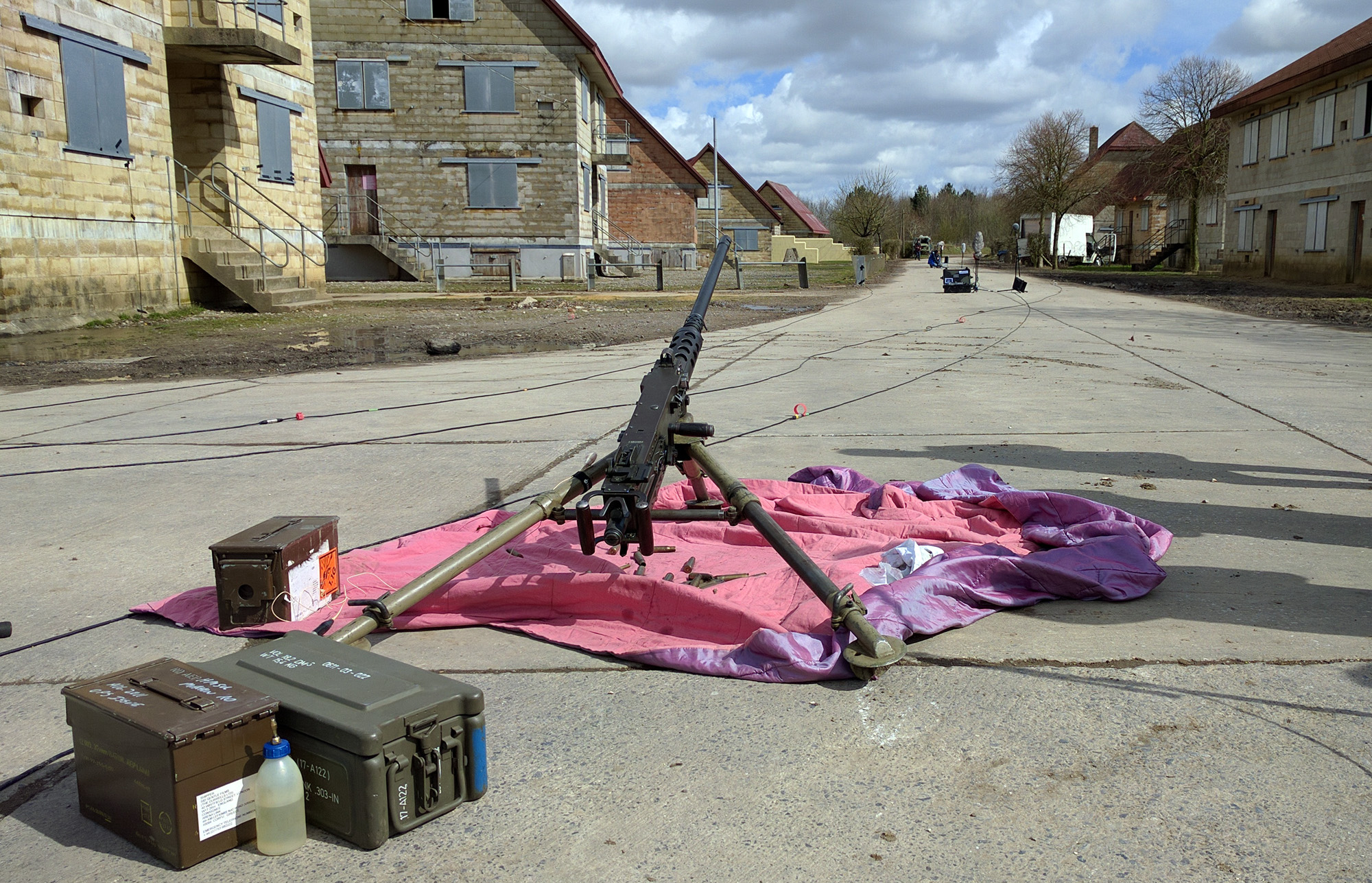
WEAPONS RECORDING PRIMER
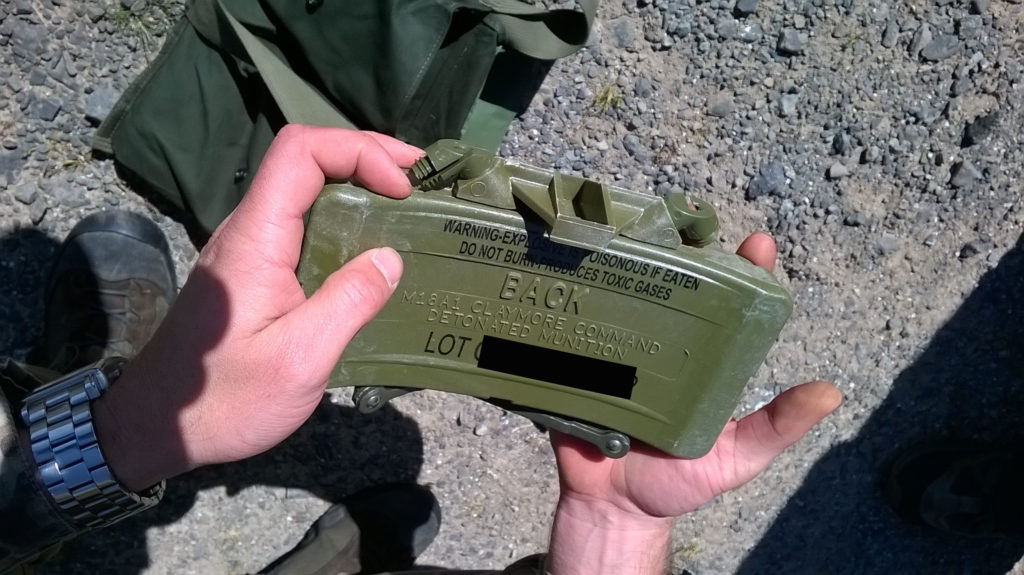
Steve Whetman – March 2019
Appox. 50 minutes long.
90% of this was previously a talk I gave at Edinburgh Festival of Sound, built from my previous blog posts and presentations starting 2012.
OBJECTIVES AND PLANNING
- Variety – Environment vs Weapons
- Lots of spaces – good for project realism
- Lots of weapons – good for mechanical variety/gameplay
- No single solution for everything
The first thing to consider is what you want to achieve, do you want to capture multiple environments or different size spaces, interiors and exteriors, or is the priority to capture as many weapons as possible in a single location.
If the aim is to capture multiple environments to use different types of tails for the project, then I use a smaller set of weapons and mics to enable the setup to be moved more quickly, or plan to record over multiple days.
Alternately the objective is sometimes to capture the largest variety of weapons using a single, more generic space, where the tails can work for multiple areas in a project. This enables me to churn through more weapons without changing or moving the setup and can use more mics this way. This gives a large variety of mechanical layers to work with, which for a games project means more varied player feedback across a game’s armoury.
Something worth making clear is there isn’t just one single way of recording weapons that works in every situation, there’s lots of amazing work done by friends and colleagues in the games and film/tv industry and we all have different methods. The most important thing for me is to experiment and keep learning, while also getting the best material I can. To add, the mics discussed here are by no means exhaustive, i’ve used many more that are great and have become staples in my sessions. Perhaps i’ll do a follow up in a few years time.
RECORDING SETUP
- High SPL – Close / Low SPL – Distant
- Multiple Perspectives – 1st and 3rd Person
- Recorder Types – Expensive vs Cheap
- Analog Limiters + Clipping = FUN!
A general starting point for mic choice and placement is that mics with a higher SPL rating can go closer to the weapon, while more sensitive mics need to be further away. Pads can help as well, assuming the capsule is happy where it is.
Using lots of mics allows me to capture multiple perspectives that then get turned into 1st person, 3rd person close, medium and far distances, or allow for camera cuts across an action scene. The number of mics I use varies from 10 up to around 30, with some being stereo or surround mics the number of channels can get quite high. I’ve found using around 22-24 mics gives me a good amount of variety with some extra for safety.
Recorders with sample rates of 96 or 192khz means layers can be duplicated and pitch shifted to make sounds bigger with less artefacts.
Some cheap recorders can be useful, if they have automatic gain compensation they can sound more like what we’re used to hearing on news reports, or documentaries. And if they get damaged it’s less of an issue.
Analog limiters for closer mics means the inputs can be driven harder which makes the recording much more fun, I drive the inputs pretty hard to get a richer and more powerful attack, otherwise if you’re too conservative with your levels you just end up with little pops.
HISTORIC WEAPONS
- WWI and WWII Machine Guns –
- Vickers
- Maxim
- Lewis
- Chauchat
A while back I did a historic machine gun recording session, the line up included 3 Vickers guns, a Maxim (the gun the Vickers was derived from), Lewis, BAR and many more. It was a huge honour and lots of fun to record these historic and rare weapons, some of which are museum pieces. I will compare the recordings from this session to others where i’ve recorded some of the same guns.
There were lots of other firearms on this session, there’s sadly not enough space or time to write about all of them!
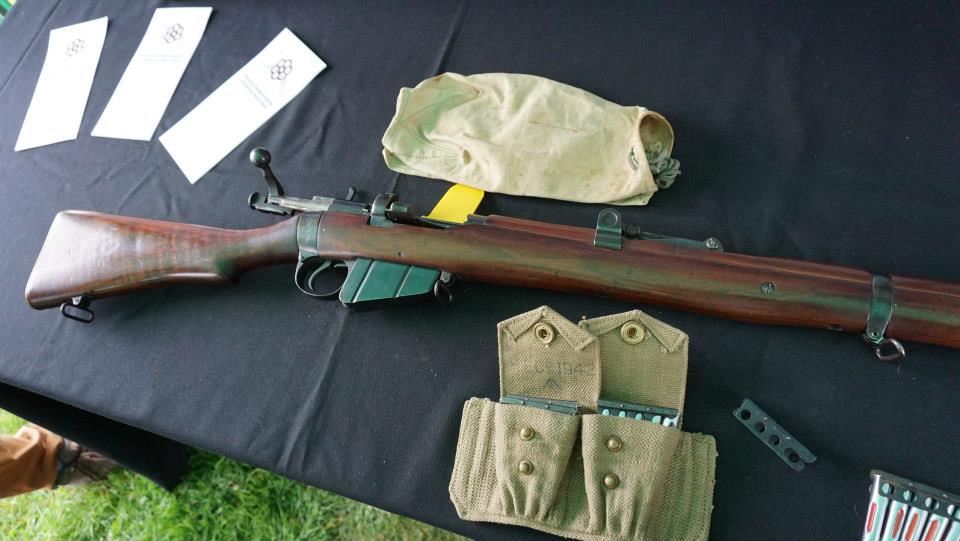
Lee-Enfield, with canvas breech cover and pouches.
This has a lovely sounding bolt action.
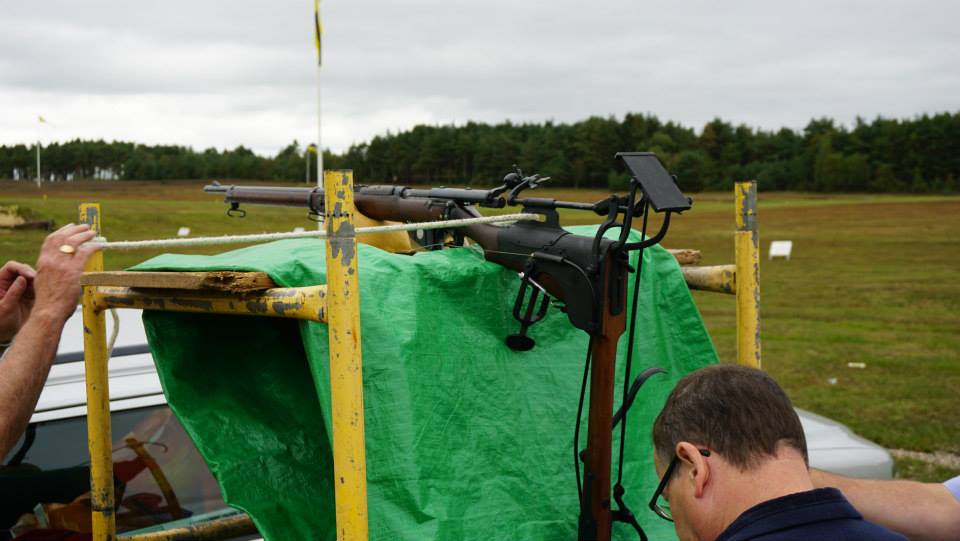
Lee-Enfield with periscope attachment, allowing shooter to remain in trench cover.
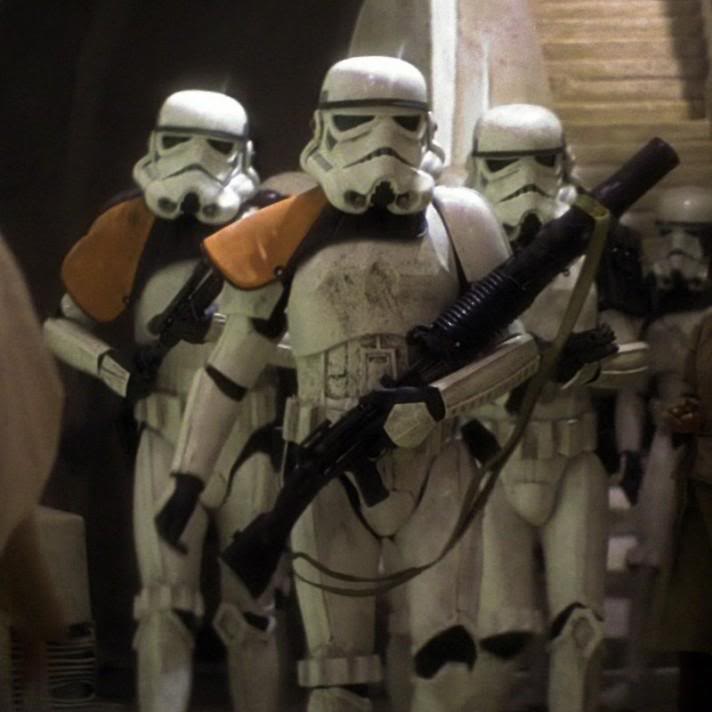
Here’s one of my favourite guns to record, the Lewis Light Machine Gun, which featured in Star Wars with minimal alterations as the Empire’s T-21 Light Repeating Blaster.
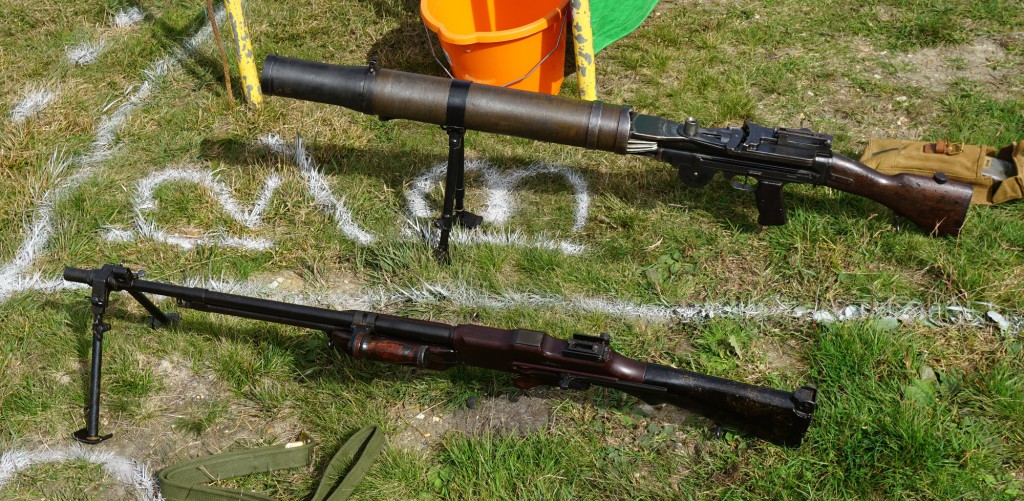
The Lewis gun top, BAR below.
The Lewis has an interesting visual appearance due to its cylindrical top mounted drum magazine (not in this picture) and the large air cooled barrel.
And it sounds fantastic, with mics positioned on the gun to pick up the mechanical elements it becomes a little like a giant sewing machine.
Here’s a clip from a 2014 session at the Bisley National Shooting Centre of a few bursts with the audio from different mics one after the other.
The gun was shot on a 100 yard range, with a sandbank wall behind the targets, and wooden sleeper tracks placed vertically to make partial walls either side. The range is part of a larger site lined with trees, itself part of a complex with other ranges in use. Some of the recordings have distant fire in them which was nice to get.
Some things worth pointing out –
You can hear the DPA 4060s (max rated peak spl 134db) just on the wrong side of being driven hot, I like to set gains nice and high for sounds with loud transients, I’m not afraid of smashing limiters, but here the mics are just slightly getting hit too hard. You can hear it drifting from good to bad where the shots become spikes without tails as the mic is recovering from the spl.
The Schoeps CMIT5 is a beautiful mic, but here this is completely the wrong place for it, it couldn’t get any closer without being driven too hard, and for practical reasons we couldn’t move it any further. Ideally I’d like to try it 50 to 300 meters away comfortably picking up lovely bright and clear distant shots.
The Oktava MK012s were positioned just at the start of the partial side walls of the range, so the recording here is super wide.
The DPA 4062 was attached to the gun, placed near the front of the stock, this very low sensitivity mic is the high spl version of the 4060 above and designed to handle a max peak spl of 154db. It’s wonderful for capturing the mechanical elements and you can really hear that in this recording of the Lewis.
The Neumann TLM102 at the end captured the character of the environment the most.
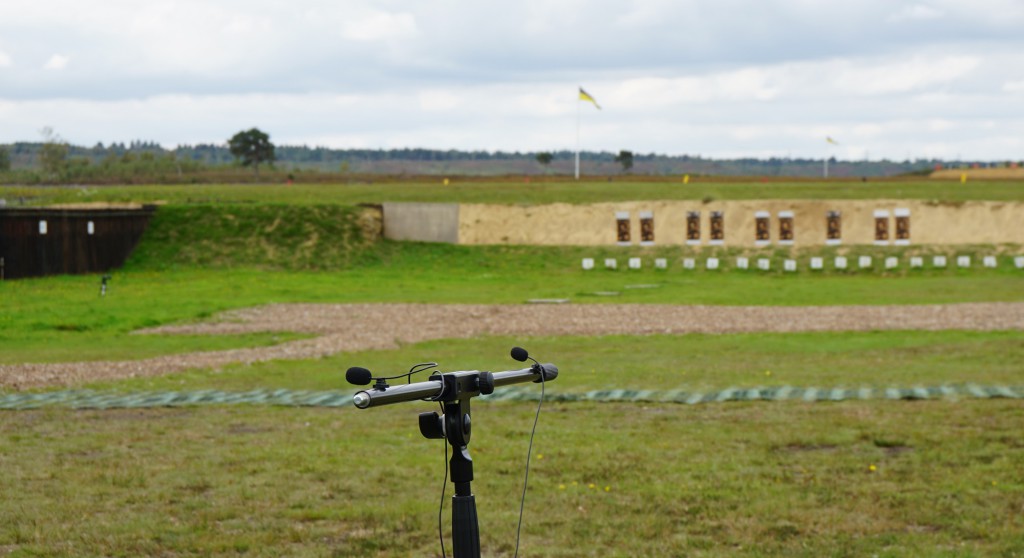
2 DPA 4060s eagerly waiting to get slammed by very high spl sound waves.
For comparison, here is a video of the Lewis recorded at the same location, but in 2013.
This is the Neumann RSM191 which was positioned just in front of the sandbank behind the targets, facing the shooter. It has a really clear series of reflections as the sound rattles between the sides of the range.
And again the Lewis gun, but from 2012 and this time a different location – Black Park.
You can hear the automatic gain compensation on the handy cam, allowing the crunchy transient to come through before locking down the level, coming up again for the tail.
The DPAs all sound awesome here, but you have to hand it to the SM57 and the Nagra 4S, such a huge, smashy sound.
You wouldn’t usually use an AKG C414 outside, especially not on a wet muddy day as this, but the tail is thick and smooth so was worth doing and I’ve used large diaphragm voice/instrument mics on every shoot since.
Stuff from these sessions got used loads for Arkham Origins and Gears of War Ultimate Edition.
The next video is of a Vickers Sidecar gun from the Bisley 2014 shoot.
The Vickers guns were water-cooled and belt fed, which makes for an interesting sound with certain mics. This was absolutely one of the highlights of my audio career.
The first mic is the Neumann U87 in the exact same position as the Neumann TLM102 was in the first video (from the same 2014 session), but the character is very different. It has a classic war movie sound to it and a more pleasing tail.
You can hear the DPA 4060s being slammed even harder here than in that first video.
And the Tascam, a cheap handheld recorder with built-in mics, still manages to pick up the belt and casing drops well.
At the end of the video I included a tiny clip of one of the other WWII Vickers guns having just been fired, steam rising from the water collecting can.
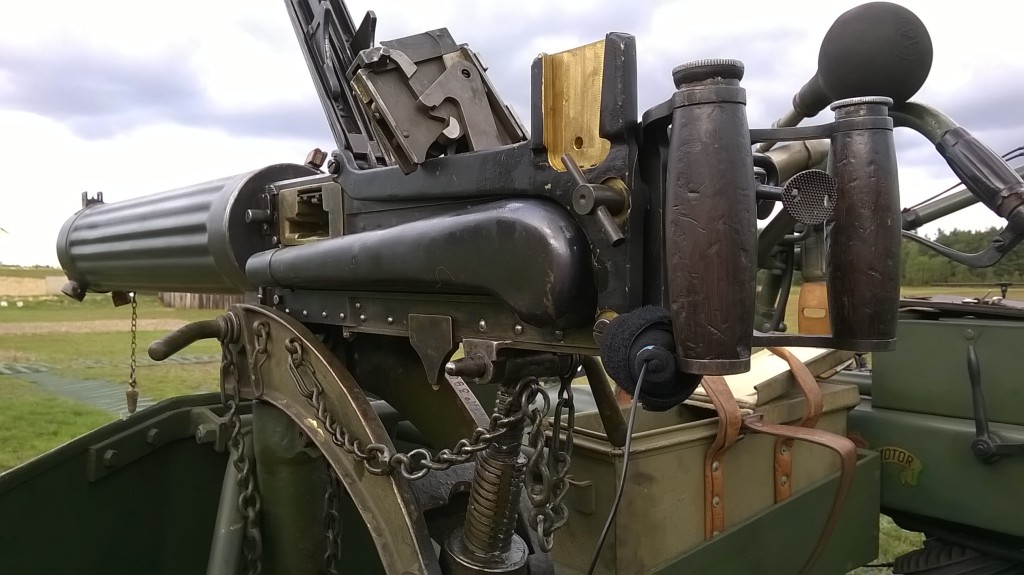
The DPA 4062 wrapped in foam and strapped to the Vickers Sidecar left handle, and has picked up the mechanical elements of the gun really well (the squeezy horn on the right also sounded awesome)
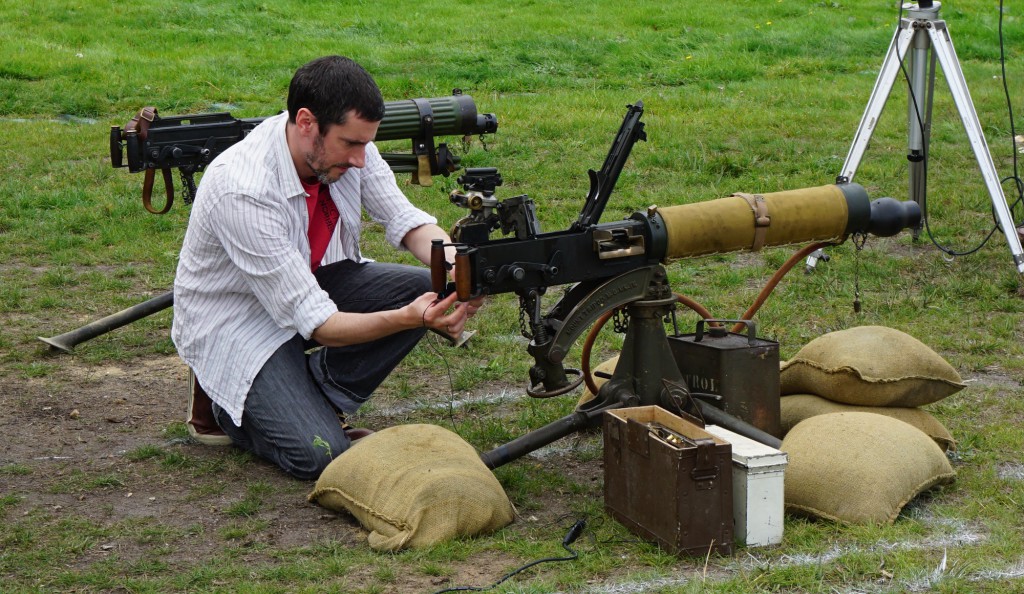
Attaching the DPA 4062 to the WWII Vickers.
This video shows the French Chauchat.
Often referred to as one of the worst guns of all time, it performed admirably during the shoot needing very little maintenance.
One of my favourite recordings of the day, the Chauchat captured by the MKH40 sounds great. I’ve included a couple of short bursts here, and then to highlight the sound of the environment I’ve included an extra clip which replaces the audio using just the first shot from several bursts, before switching to the tail.
I’ve done this to demonstrate how the sound propagates through the environment over time (around the time of the 2nd second shot of a burst depending on ROF), and so using just the first shot of several bursts allows us to remove the sound of the environment to an extent, albeit roughly demonstrated here, this can sometimes be useful when you’re designing sounds. And something to consider if you’re recording bespoke material for a project, think about how you’re going to implement your weapon audio and what format is best for recording, single shots or bursts etc. This is a huge discussion that I love to talk about with other sound folks, so get in touch if you want to share approaches.
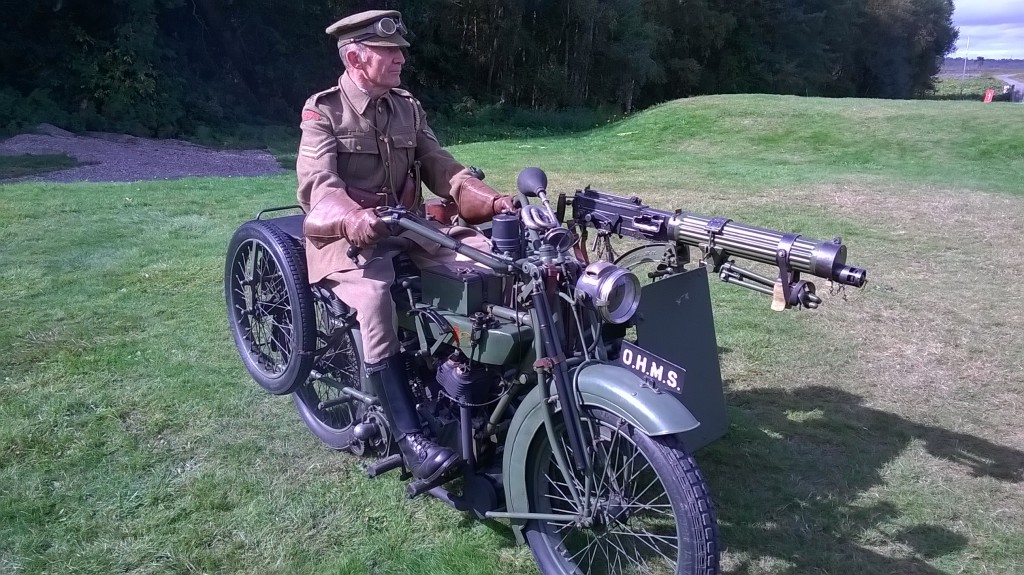
Here’s the bike mounted Vickers being driven into firing position.
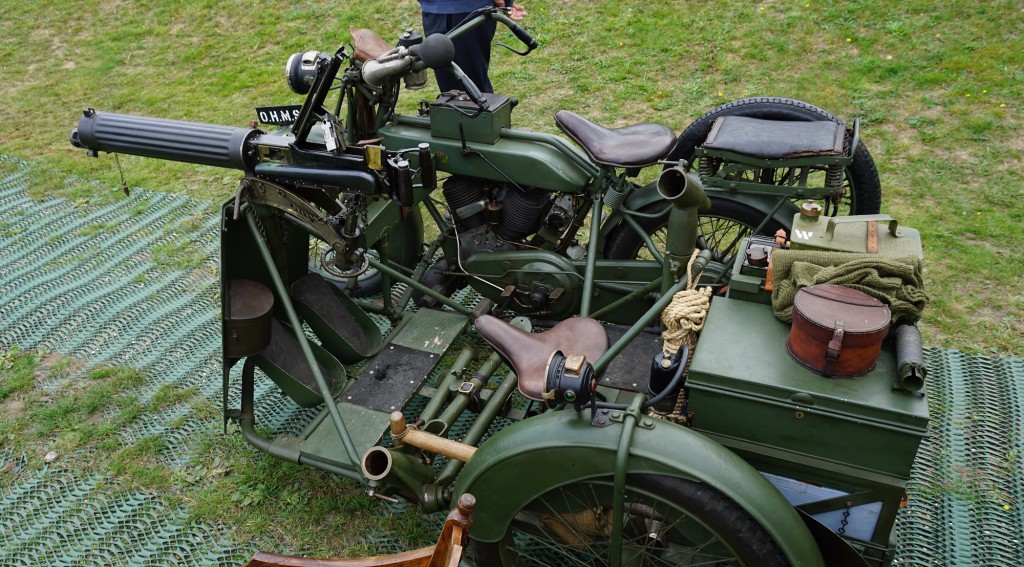
Awesome machine.
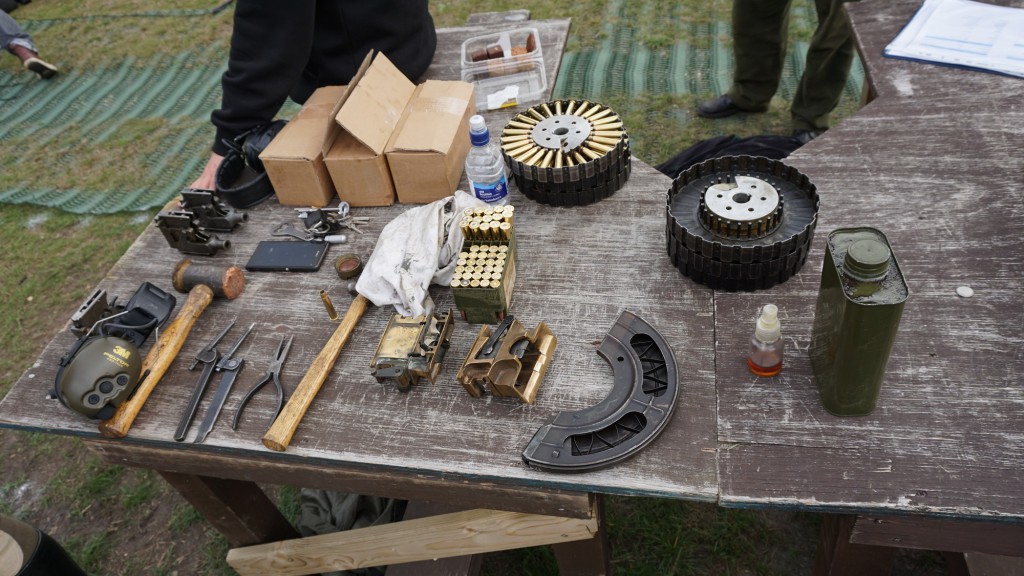
Lewis magazines, Vickers bolts on the left, Semi-circular Chauchat magazine on right, and tools.
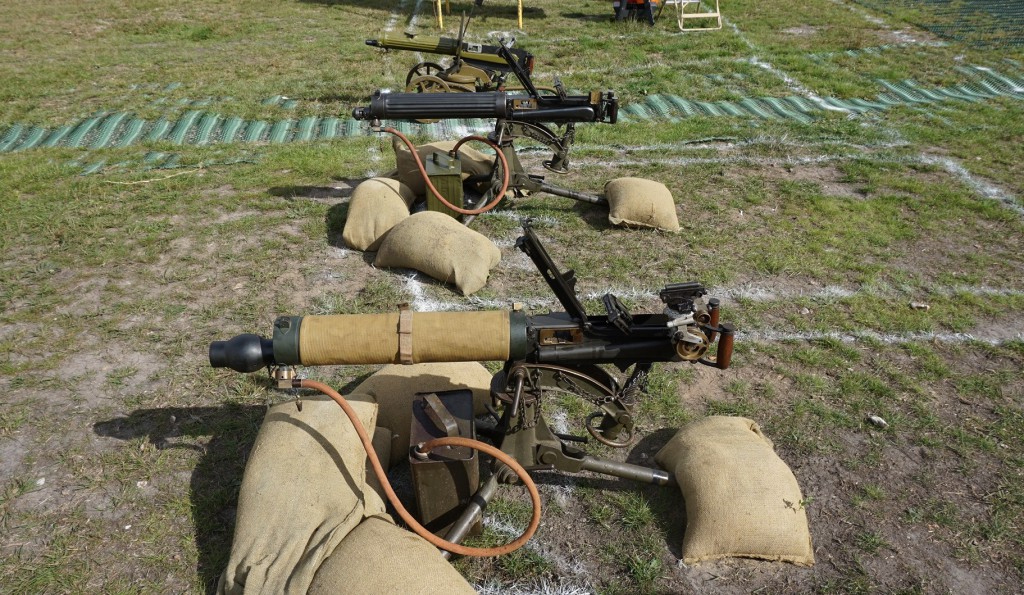
A trio of machine guns. From bottom to top – WWII Vickers, WWI Vickers and the Maxim.
THE SPECIAL FORCES
- 4 days with SAS in training exercises
- Running to their schedule – setup and run
- NLAW – Anti Tank Missiles
- Mortars
- Grenades
In 2015 myself and a good friend and colleague from Splash Damage spent a few days with the SAS on various training exercises.
It was a very educational experience that gave me a tiny glimpse into what life is like training for the SAS, and hearing first hand about the experiences of people who had served in the Forces was fascinating. Alas, I can’t talk about any of that, on to the recordings.
Working with the armed forces everything has to be to their schedule, when they’re running exercises we would get a heads up of when it starts, a short time to get gear into place, and then clear the area.
NLAW – Next Gen Light Anti tank Weapon
- How did it come to this
- Didn’t get blown up = win
- Unique recordings?
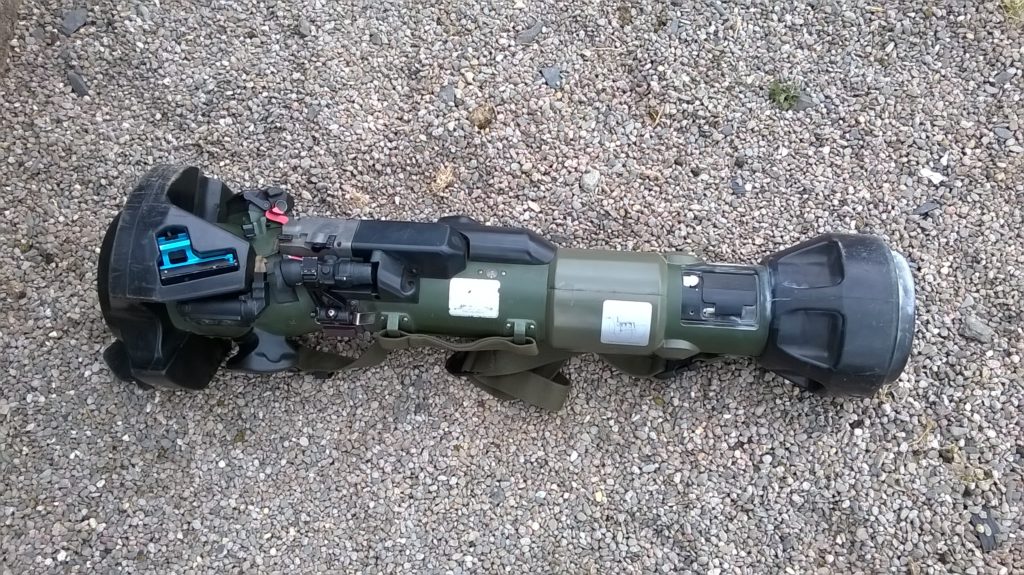
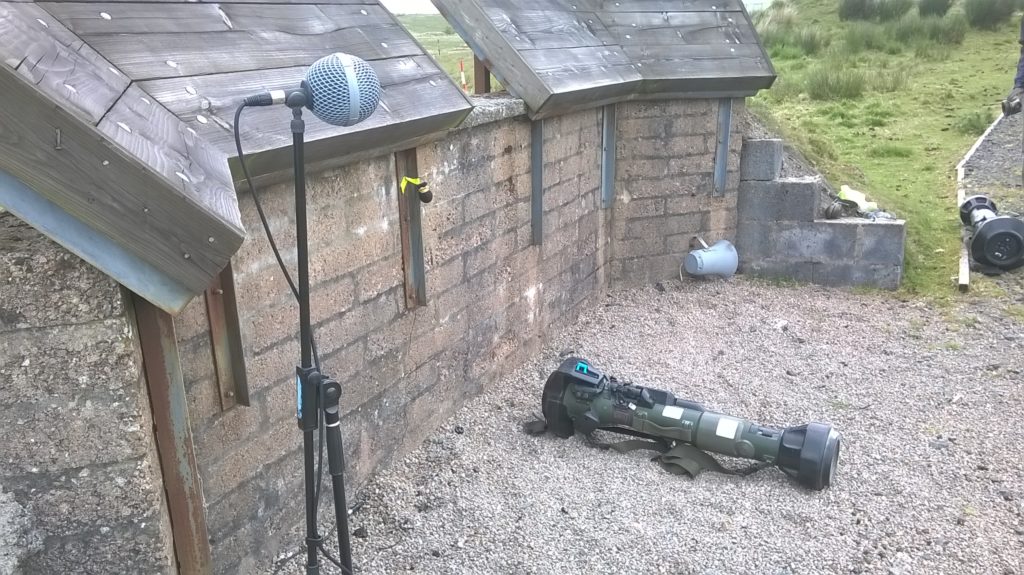
An NLAW waiting at the firing point, with the DPA 4062 taped to the wall just beside it.
Here’s some of the recordings.
Things to note for this video of the NLAW, while the DPA 4060 pair of omni mics pick up the ambience of the environment wonderfully they don’t handle the wind too well, however they did get plenty of bass from the distant explosion.
In some of the recordings you can hear some debris from the launch of the missile, this might sound like recording artefacts but these are specific parts of the casing which are designed to disintegrate on launch.
High SPL shotgun mics sound great on this type of material, as they do on other weapons.
The Olympus LS5 (and other LS series recorders) is dirt cheap and sounds great on pretty much everything it get’s used for as long as you have a decent windshield.
I wasn’t allowed to attach a mic to the launcher itself, but i was allowed to put one on the shooter. The DPA 4062 on the shooter’s lapel sounds absolutely awesome, you can clearly hear the trigger, then the missile detach, and then the launch.
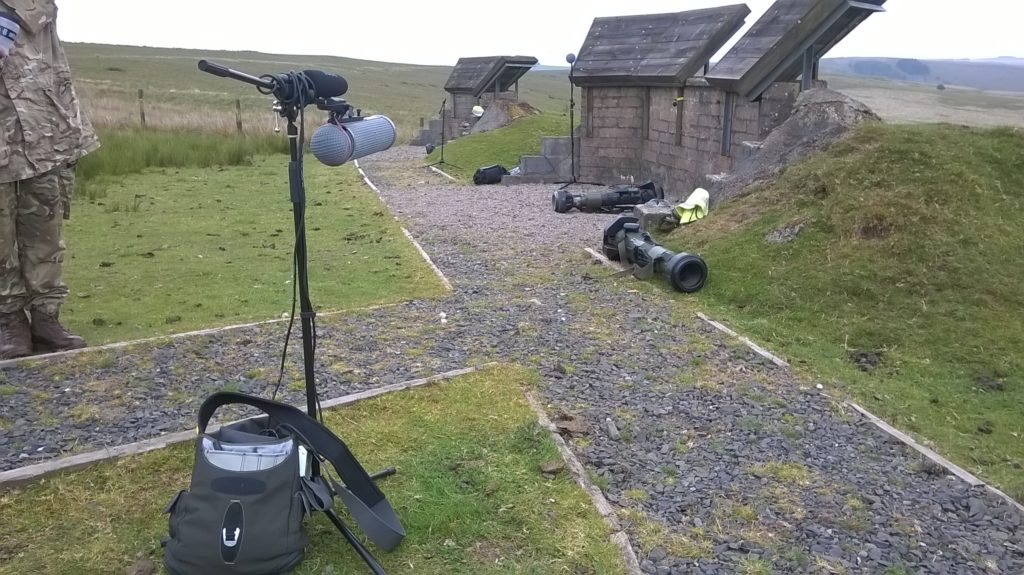
Franken-mic setup on the left here, it doesn’t matter what it looks like just what it sounds like. We didn’t have long to set this up. The NTG3 and MKH416 are on the left here, the 8040 is in the centre of the picture just to the edge of the firing bay.
I’ve not seen or heard about any other recordings of an NLAW, if you have done some please get in touch. I love to hear and discuss different approaches to recording.
MORTARS
- Quiet Launch
- Long Travel Time
- Big Explosion
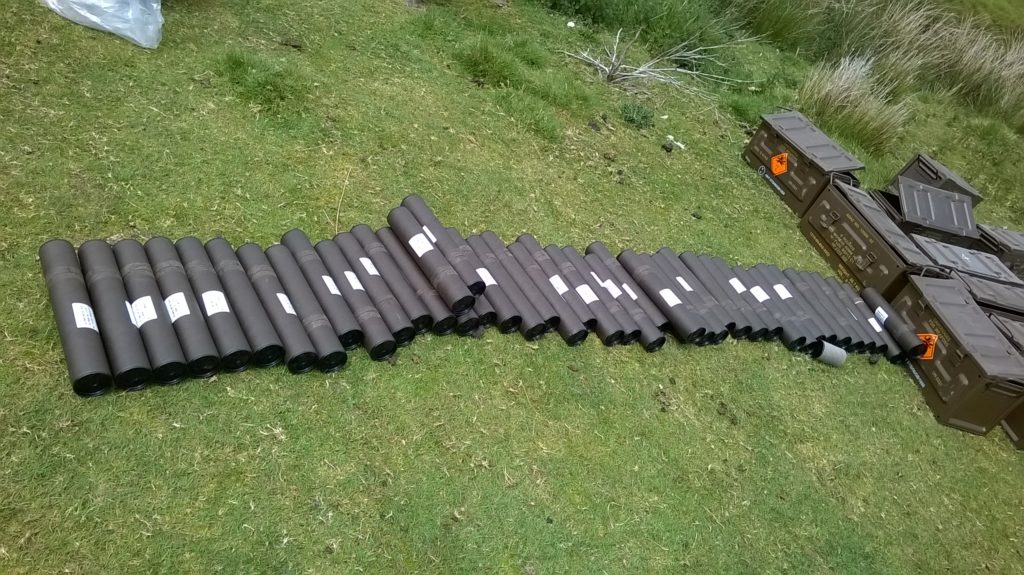
Mortars have a fairly quiet launch, a long travel time and that travel can sound really interesting and i would have loved to have captured that more. The explosions are big but for these i was only able to setup mics on the launcher side of the valley. This was due to mortars possibly ‘going blind’ meaning unexploded, you don’t want to step on any of those.
It’s a little hard to see in the video, so here’s the impact spot –
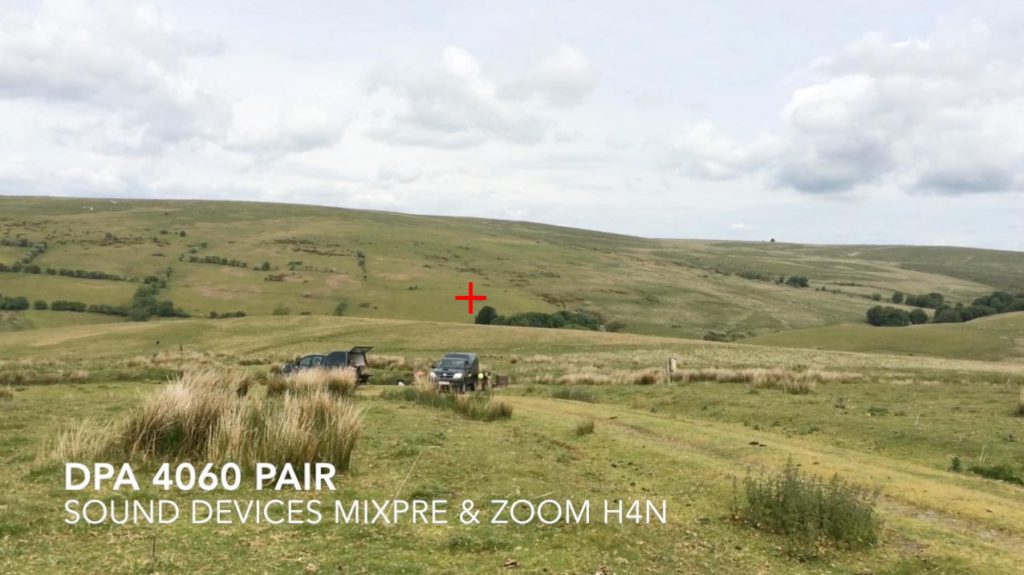
Mortar video.
The MKH416 here is ok, nothing remarkable, if you have the option there are better choices of mic out there in this bracket now. I can’t be too harsh on it though because sometimes it does great work, as you’ll hear later.
The Sound Devices Mix Pre and Zoom H4n is a great combination that gives you a really good input stage and recorder on a budget. The 4060 pair captures a nice swirl through the air, and mega bass on the impact.
The Neumann KU100 Binaural head (Binaural Barry) does an incredible job of capturing the propagation of the explosion as it ripples left and right through the valley.
I was allowed to attach a DPA 4062 to one of the mortar launchers, so you’ll hear what it’s like to have an ear on a launcher as it’s setup, with a mortar dropped in, and launched.
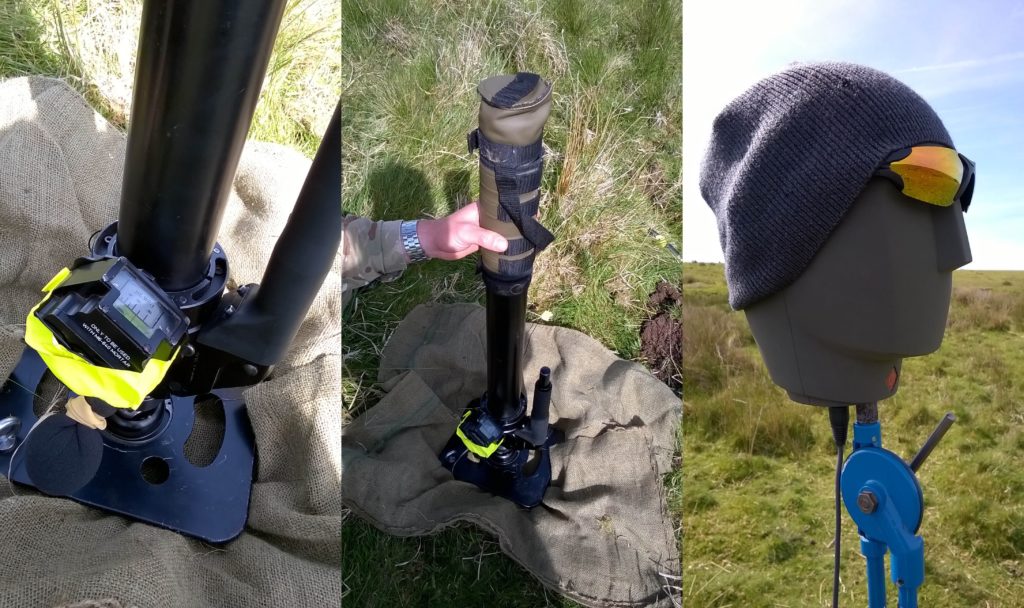
Here’s a close up where the 4062 was attached. And Binaural Barry looking hyped for some recording.
CLAYMORES
- Big bangs
- Good Health and Safety
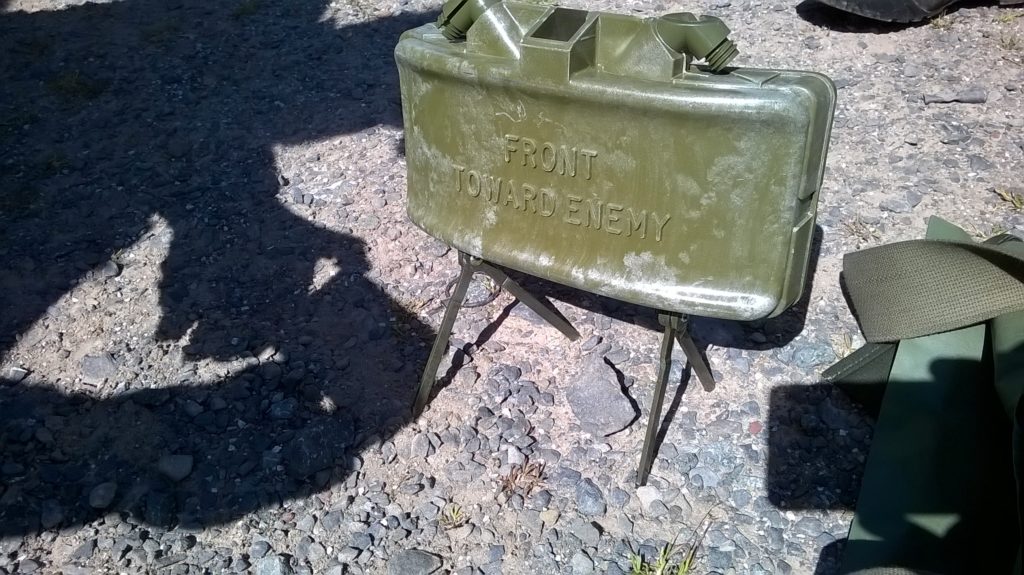
Here’s a Claymore, it has instructions on it including a warning that the contents are explosive and not to be eaten. Always good to see health and safety taken seriously.
In the interest of finishing all this and sharing it i’m just uploading the audio, the video for these wasn’t amazing anyway.
MKH8040 at 20m
First up is the MKH8040 at 20m, i did get mics closer but none of them were any good, they were either too close or not close enough because i didn’t know where exactly they would be planting the Claymores.
KU100 at 200m
Binarual Barry sounds a bit overwhelmed here, even at 200m, he’s quite sensitive. The tails came out a bit odd too, as an experiment Barry was placed in a trench.
Olympus LS5 at 200m
After a bit of bird clean up this will be amazing. A quick, sharp crack like condensed thunder before the wall of bass.
DPA 4060 pair at 600m
This turned out really well, strangely no birds over this way and a lovely perspective.
L109A1-HE GRENADES
- Interesting Transients
- Recordings worked out great
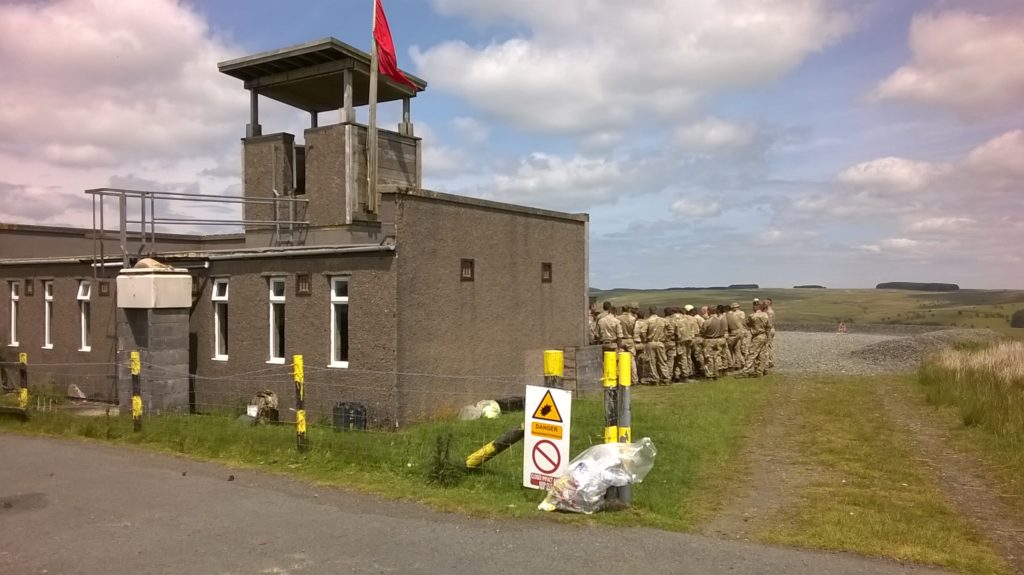
Here’s some fragmentation grenades being thrown into a stone target area (the background of the photo above), I was able to get the mics pretty close for this and wasn’t afraid about losing any if they were too close. Not often you get to record live grenades so it was worth the risk and no mics were blown up.
DPA 4062 at 10m
Tasty crushed transients and fast follow through of bass, with very little environment which means great for sound design. High frequencies a bit closed down due to being 10m from source.
MKH 8040 at 10m
Bit more open sounding.
U87 at 20m
This is a really, really old U87, not one of the AI versions. And wow, in the right situation it can really do a great job, the bass here is bonkers.
Olympus LS5 at 20m
Got the LS5 at 20m for a bit and then moved it out to 200m…
Olympus LS5 at 200m
Both nice perspectives.
URBAN ENVIRONMENTS
- The holy grail for film/game weapon sound?
- Hard to record guns on your average street
- SLAP SLAP Slap slap slap slap
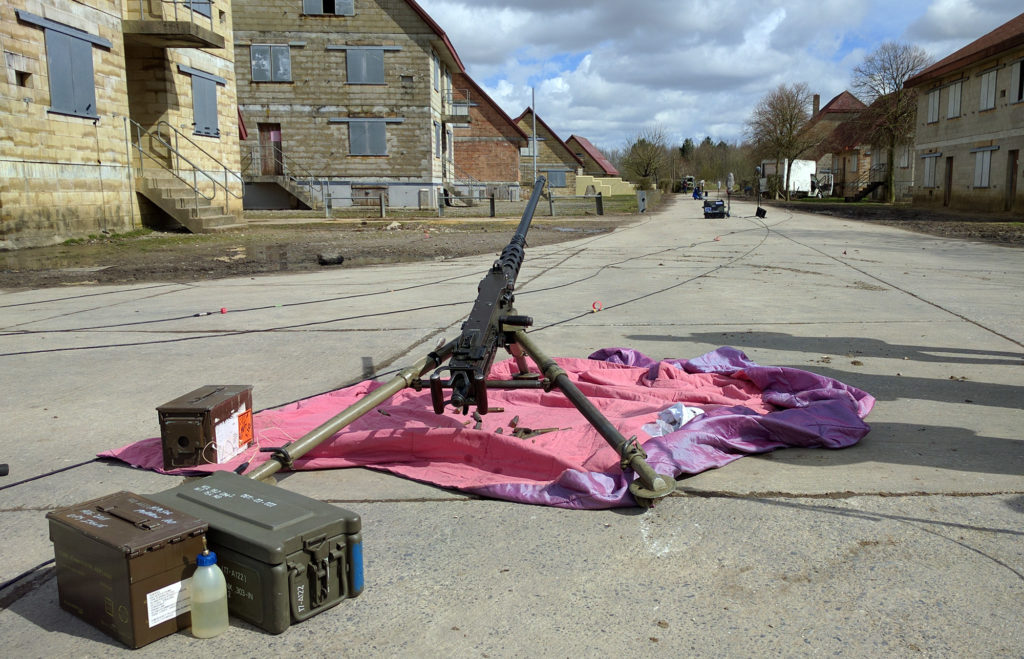
I’ve done a fair few urban environment sessions in various spots, all good and different, but none quite as outstanding as the time I went to a Ministry of Defence training site – a FIBUA = Fighting In A Built Up Area.
Wide streets with decent sized buildings situated symmetrically to provide a clear and well defined series of reflections, with very little else to get in the way.
The first project to release with these recordings on was the Brad Pitt film, War Machine. I’ve used them loads since then. You can grab them on asoundeffect.com i’ll add a link at the end.
FIBUA STREET – BROWNING M2 .50 CAL MACHINE GUN
As recorded in position from photo above.
DPA 4062 – On Gun
So much metal, so mechanical, always a win.
DPA 4006 Pair at 2m
Absolutely ferocious. This pair of mics is pretending it’s 1995 and we are doing that gritty Hollywood heist film with that urban LA shootout.
DPA 4060 pair at 50m
Placed super wide, on opposing buildings either side of the road. The capsule on the right just breaking up a bit here for a short time. You can’t rely on using a single or double tap shot for a level check, and then recording a long burst, it’s tough to know how some mics will behave over time when they are pushed hard. Plan for lots of takes with listening between.
Binaural Barry at 100m
Standard Barry, nice one.
FIBUA Street from 50m, you can’t see them but the DPA 4060s are here –
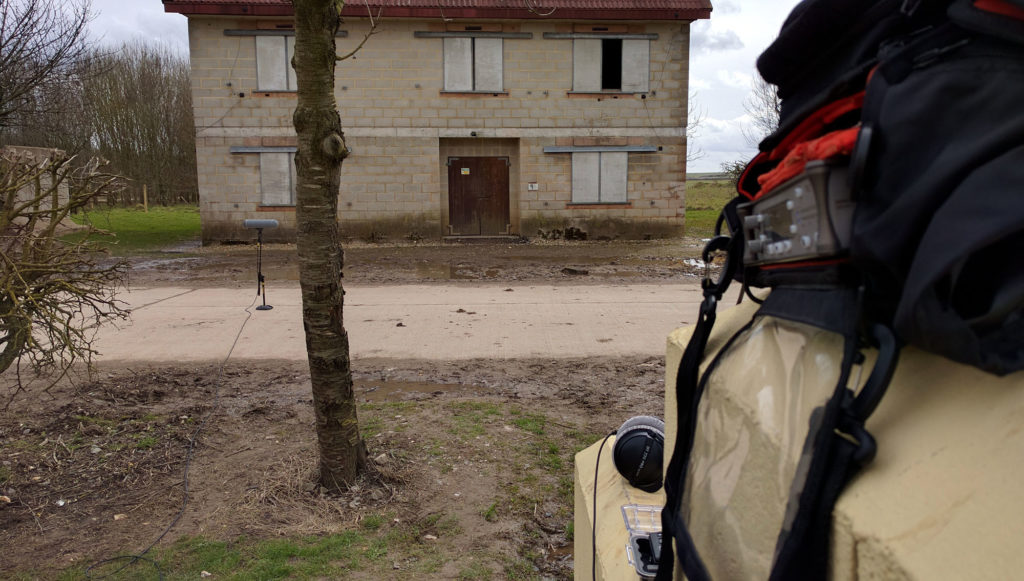
FIBUA Street, distant, facing shooter –
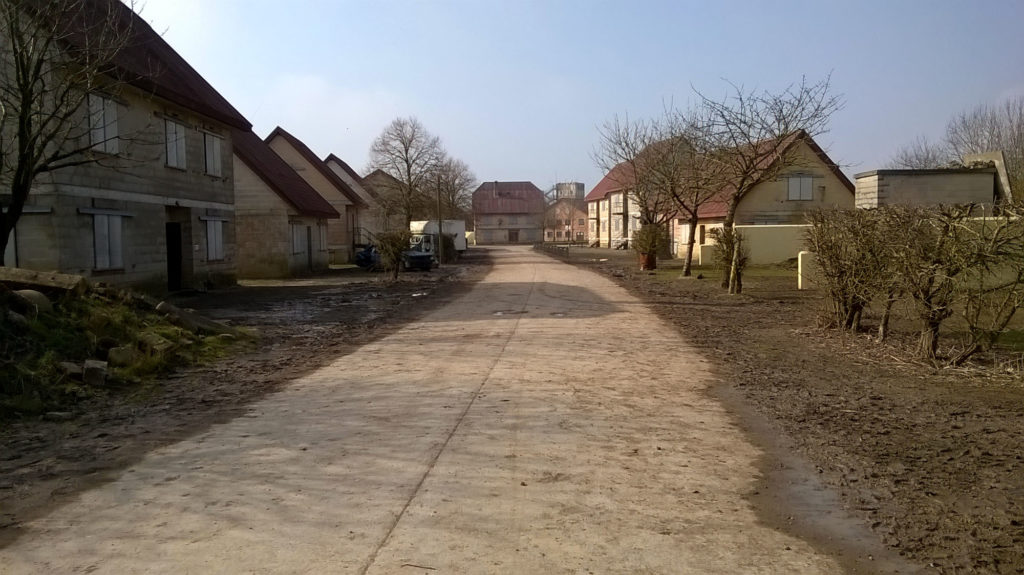
FIBUA GAS STATION – G36 SMG
The shooter was positioned just the other side of that APC on the right here –
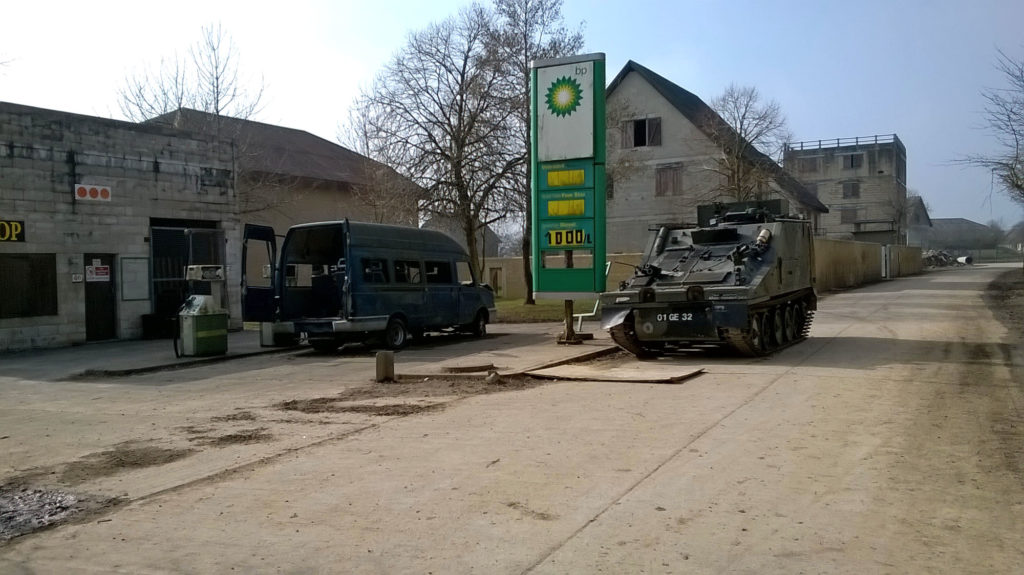
DPA 4062 – On Gun
A bit of 4062 action for reference, the G36 is switched to full auto after the first shot and sounds very nicely metallic/mechanical.
MKH416 at 20m Part Occluded
I think there are better shotgun mics around for pretty cheap these days, but the 416 here has done a great job. Those reflections are to die for.
The partially occluded 416 was in the fake graveyard on the far side of this picture, with the gas station and street just beyond the houses opposite.
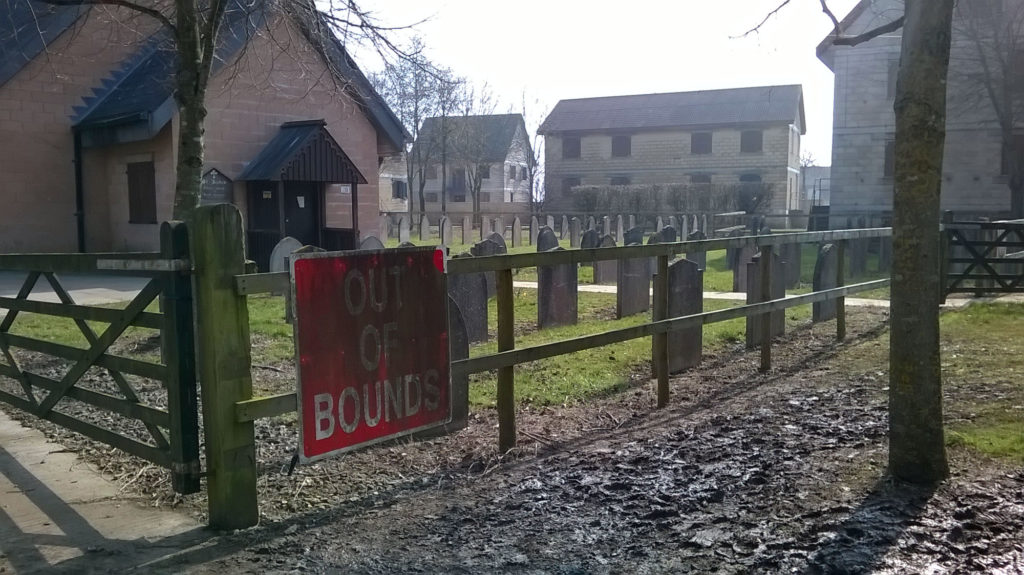
INTERIORS
- Different Set of Challenges
- Windows, Ceiling Tiles, Lights Dust and Debris
- Interior Firearms Recordings Were Very Scarce
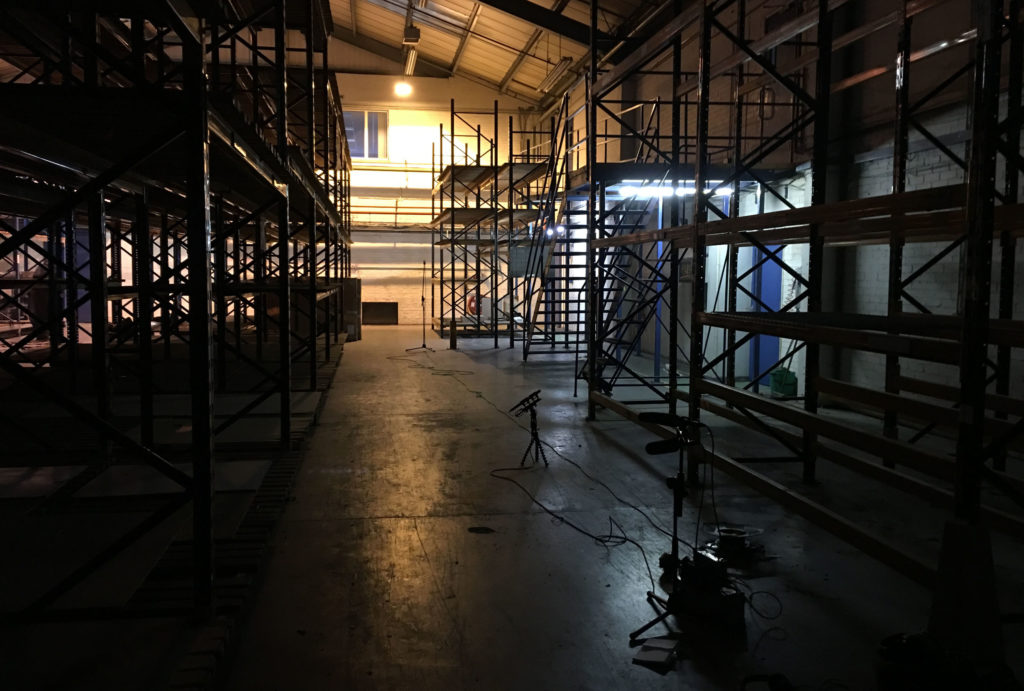
Recording interiors has a different set of challenges, because of the pressure from more powerful or higher calibre firearms it’s important to be mindful of the space you’re in. Things like windows, ceiling tiles, light fixtures are all easy to break.
When you fire a weapon in an office or some other interior space, the blast brings up a lot of dust. Any dust or debris in the room suddenly becomes airborne and that makes it difficult to work as you can’t breathe properly. I recorded a shotgun in an ordinary open plan office and the ceiling tiles were jumping significantly, the office got filled with dust almost immediately so we had to break after every few shots and clear the air.
Interior weapons recordings are pretty rare, I needed them for my projects and others were asking me too. I’ve done a few now, one of which i’ve made into a library so others can get the material without the expense of a bespoke session (link at the end).
The first indoor session I did I got really lucky, a friend had a contact that owned a warehouse with a loading bay and offices in London, the Met Police are very familiar with people filming/recording in London so an advance phone call ensured everything would run smoothly.
I’ve just used these recordings on a film due out later this year with almost no processing, there’s a big indoor shootout and these recordings worked great, once i’m allowed to talk about it i’ll post it up.
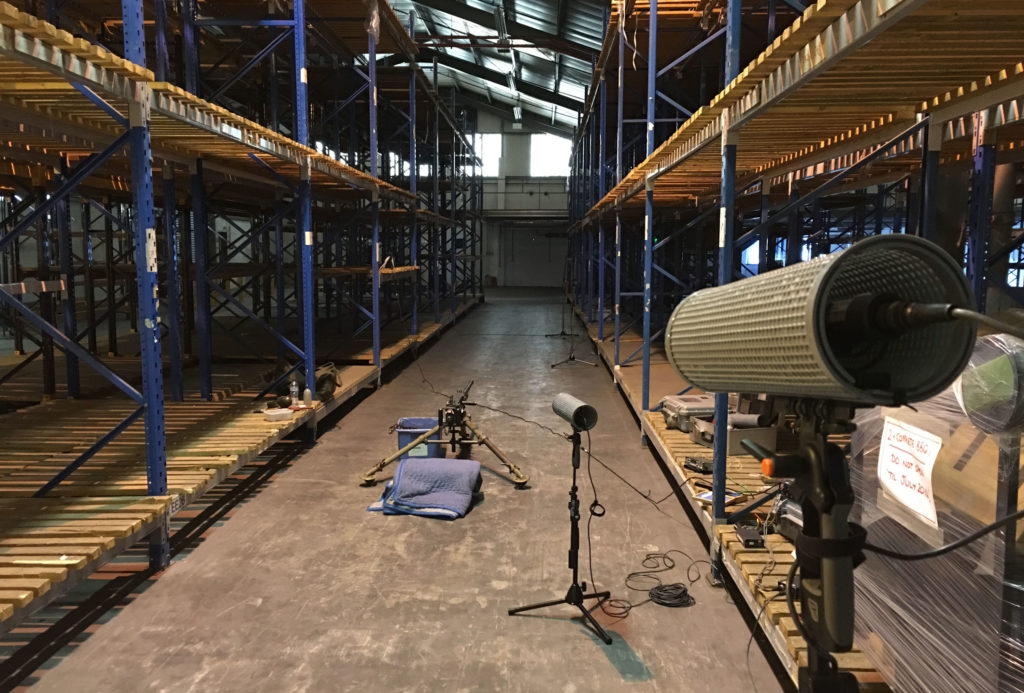
WAREHOUSE – STEYR HS .50 CAL SNIPER RIFLE
The muzzle break means there’s not much recoil, however the wave going left and right is pretty substantial and i should be wearing eye protection here.
In general, as the mics get further back you start to hear more discrete reflections, which varies the tails nicely. This Steyr .50 is just over the edge of what i’ve found I can put a DPA 4062 on. If you’re happy to have unusable firing but nice mechanicals then that still works nicely.
Switching between the close and distant stuff from these sort of sessions means I can do a scene with constant camera cuts between close and distant firing, with pretty much no processing and it’ll work. For games also, being able to have different perspective on this sort of material is really helpful.
STAIRWELL – COLT M1911
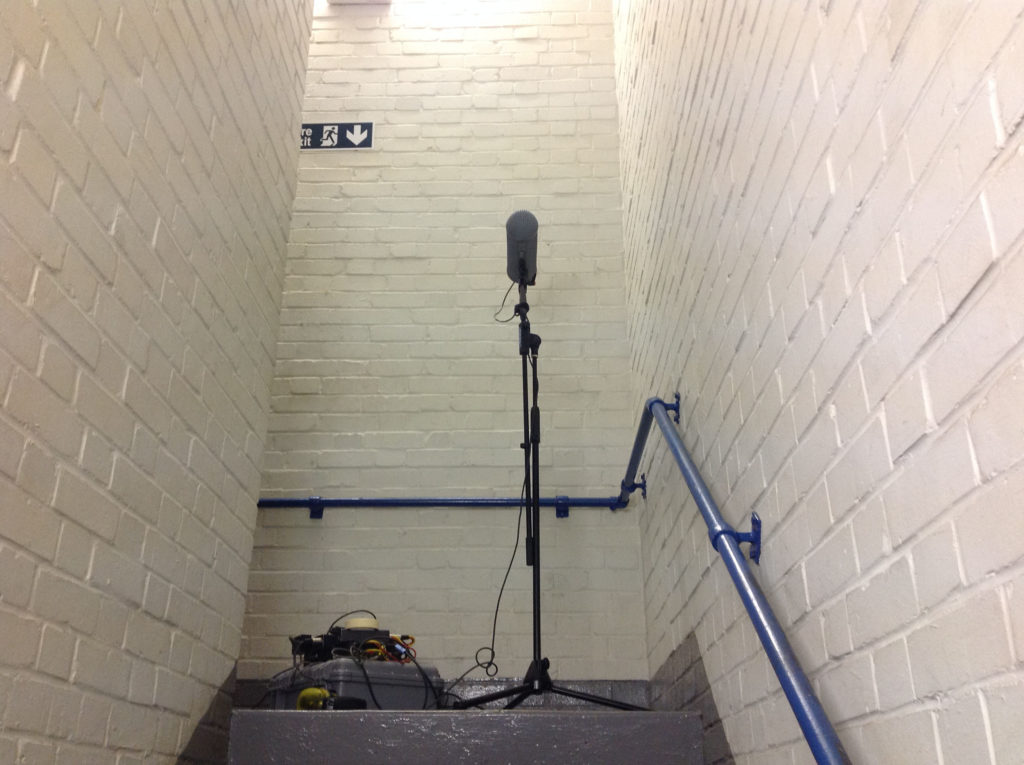
DPA4062 – On gun
Here’s the other end of the scale, a Colt M1911 pistol being fired in a stairwell. Uploaded 3x shots to hear the subtle difference in tails. The tail can be cut just before it changes to the ringing part to give a more enclosed, intense and noisy sound which is lots of fun.
MKH40 at 6m
Madness, a little on the hot side but then it wouldn’t be fun otherwise. Layered with a clean mechanical recording and designed a touch, this works nicely.
TO FINISH!
TOILET CUBICLE – SHOTGUN
- Only so many mics worth putting in a small space
- Small space + lots of resonating objects = difficult to record quickly
But fuck all that logical shit, to finish, here’s what it sounds like to be on the toilet and someone fires a shotgun at you.
It’s a SPAS 12, not that the type of shotgun really matters when someone wants to shoot you while you’re otherwise occupied.
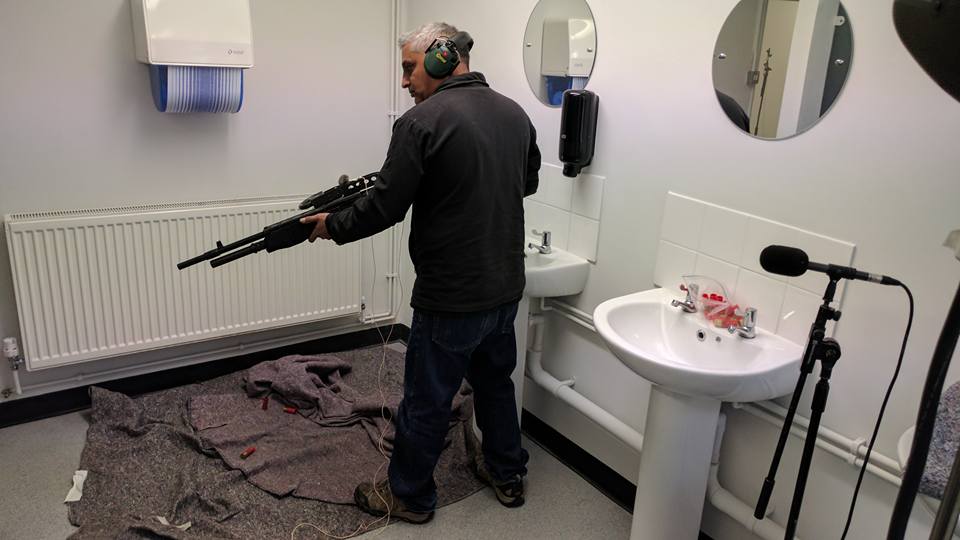
I recorded this with a bunch of mics, this is the Sennheiser Ambeo, a really capable mic that can handle being pretty close to things like shotguns, it’s positioned in the toilet cubicle.
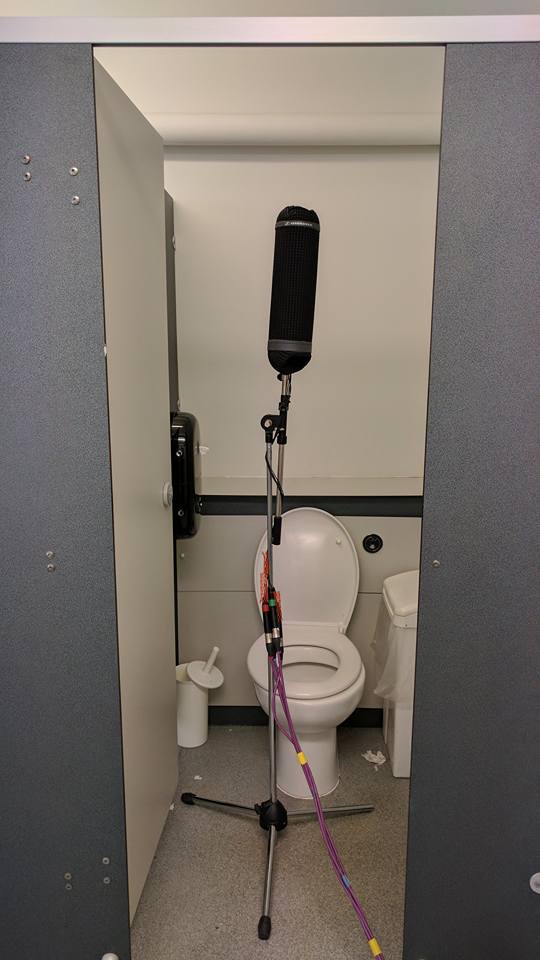
FINAL NOTES
- It can be done – start small and have fun (safely) doing it yourself
- Plan A LOT (map your mic positions, cable runs/lengths, recorder channels, label everything, rounds per weapon)
- Ensure the authorities know about it
- Break plenty to listen and make changes to setup
- Thanks to everyone who’s been involved with any of these sessions
If you’re after indoor gun recordings or urban material you can get my 2 libraries here –




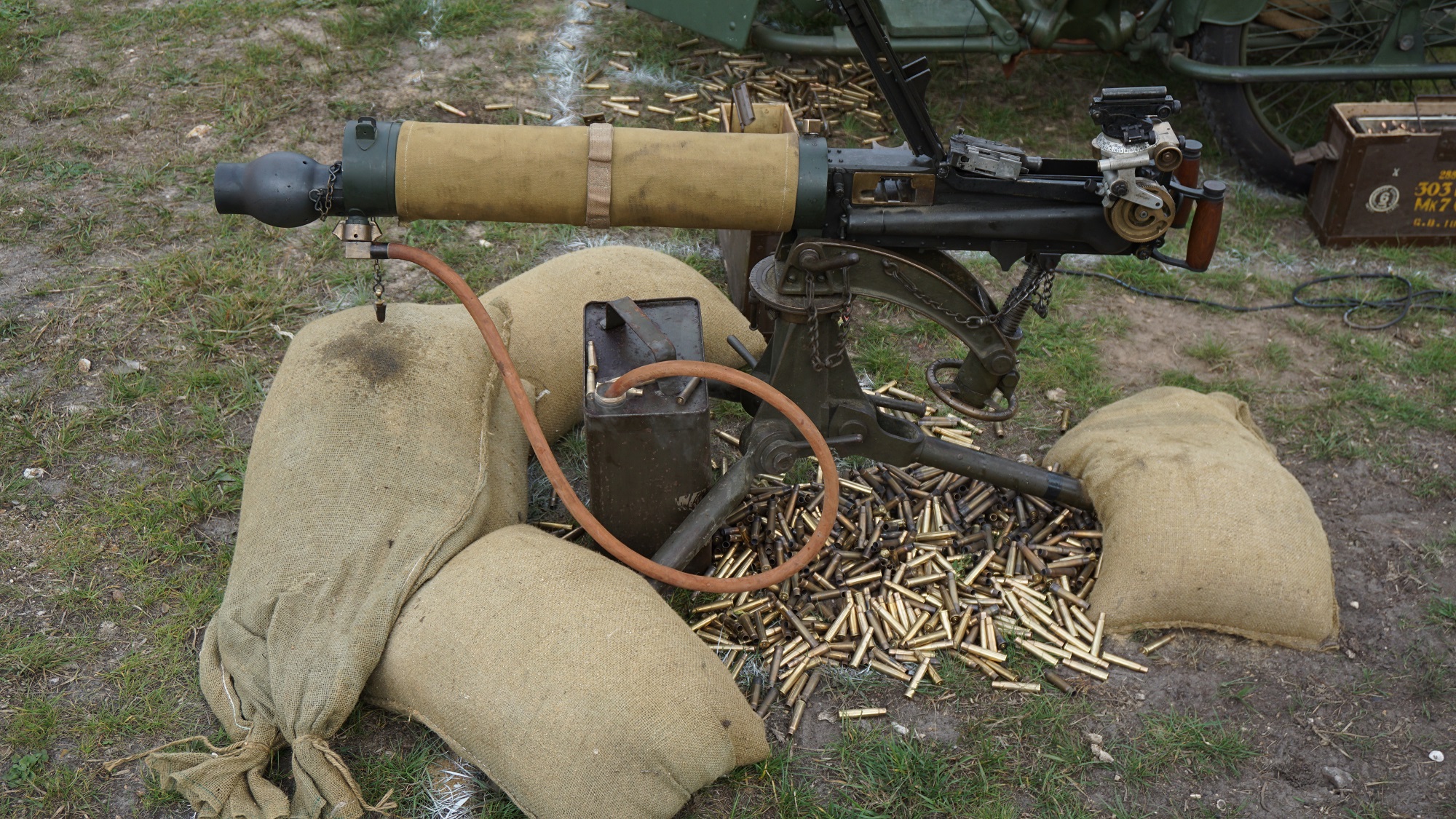
Justin Prymowicz
Amazing article! The amount of detail you’ve documented is great! Thank you!
feedme
Thank you Justin, glad you enjoyed it. It was a lot of fun recording all the sessions and i thought it would be nice to share.
Lyubomir Goshev
Thank you so much, Steve! Extremely useful info! Exactly what I needed for my first weapons session. Thanks again and share more 🙂